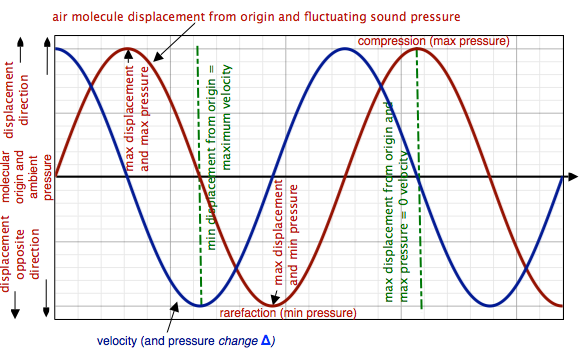Chapter One: An Acoustics Primer

2. What is Sound? | Page 3
Molecular displacement, velocity and pressure
While an overall sound wave propagates out from its origin at the speed of sound, consider the contribution of a single air molecule in the wave: it moves first in one direction away from its equilibrium position, then in the other, passing through its origin and out to the opposite extreme.* What about its speed? Is it always traveling at the speed of sound, like the overall sound wave? The answer is no—it is not!
Air molecules participating in an idealized sound wave accelerate smoothly in one direction, slow to a halt at the pressure extremes of compression or rarefaction, and then smoothly begin to accelerate in the opposite direction, much like the end weight of a swinging pendulum. Inertia, however minute, prevents the molecule from suddenly switching direction at its maximum velocity. The molecule’s changing velocity is shown by the BLUE cosine curve in the graph below. Its oscillating position in space and the local sound pressure at the molecule are represented by the RED sine curve. The molecule reaches maximum speed as it passes through its origin, then gradually slows to a halt as it enters an increasingly dense clump of molecules at maximum compression (maximum pressure). From there, it begins to accelerate in the opposite direction, reaching maximum velocity again at its origin, and then slowing to a stop as it finds itself alone in a state of rarefaction (minimum pressure). From there, it begins to accelerate toward its origin once again to continue the cycle. This is like a swinging pendulum: the end weight achieves maximum velocity at what would otherwise be its state of rest (equilibrium), and its minimum velocity occurs at either extreme of the swing.
In the graph below, note that maximum displacement and extreme pressures (maximum or minimum) correspond to the minimum of the air molecule’s velocity, and that the air molecule’s maximum velocity corresponds to the minimum displacement and the smallest pressure change.

It may seem counterintuitive that at the peaks and troughs of sound pressure the molecules are not moving at all (or, in the real world, moving minimally), yet they move fastest at the point of minimal overall pressure change (equilibrium)! Mathematically, the above chart demonstrates that if the motion of the molecule's displacement forms a sine wave, then the corresponding molecular velocity and rate of pressure change (or pressure delta) are in a cosine relationship.
Greater molecular velocities mean greater sound-wave amplitude. Amplitude in acoustics refers to the degree of change in atmospheric pressure above or below the ambient (equilibrium) pressure. The primary determinant of amplitude is the maximum velocity of individual molecules involved in the wave.

Transfer of Energy
To impart individual particle velocities to adjacent molecules, a force—a transfer of energy (what physicists call work)—is required, and this often occurs across mediums. For example, a bass drum head, when struck, will impart its mechanical energy of physical oscillation to the adjacent air molecules, causing them to move to and fro as outlined above and transferring their kinetic energy to other adjacent molecules. As the sound wave propagates through space in this fashion, perhaps a small portion of it will strike your ear drum causing it to oscillate in a fashion proportional to original bass drum head. As described later in our psychoacoustics chapters, these minute eardrum movements will be converted into fluid vibrations, and then into electrochemical nerve signals that will communicate these pressure changes to your brain. Your brain may decide the pattern of these oscillations seems familiar, and you may say to yourself, "I think I just heard a bass drum!"
A fantastic, concise description of the relationships among sound, energy, force, work, power, amplitude, pressure and velocity (at a level easily understood without extensive scientific training) can be found in Mark Ballora: Essentials of Music Technology (2003).
*The above explanation is an idealized version of reality, assuming molecules of a sound wave move reciprocally back and forth along a single axis, whereas in reality, they are bumped and jostled in many directions—but this model is useful as a generalization of the sound-pressure wave model.